Analysis of Seismic Damage Zones: A Case Study of the Ordovician Formation in the Shunbei 5 Fault Zone, Tarim Basin, China
Abstract
1. Introduction
2. Geological Setting
3. Data and Methods
4. Results
4.1. Characteristics of Shunbei 5 Fault Damage Zone
4.2. Relationship of Damage Zone Width with Throw
5. Discussion
5.1. Factors Affecting the Damage Zone Width of the Shunbei 5 Fault Zone
5.2. Implications for Growth of the Shunbei 5 Fault Damage Zone
5.3. Influence of Fault Damage Zone Characteristics to Hydrocarbon Exploration
6. Conclusions
Author Contributions
Funding
Institutional Review Board Statement
Informed Consent Statement
Data Availability Statement
Acknowledgments
Conflicts of Interest
References
- Caine, J.S.; Evans, J.P.; Forster, C.B. Fault zone architecture and permeability structure. Geology 1996, 24, 1025–1028. [Google Scholar] [CrossRef]
- Kim, Y.S.; Peacock, D.C.; Sanderson, D.J. Fault damage zones. J. Struct. Geol. 2004, 26, 503–517. [Google Scholar] [CrossRef]
- Shipton, Z.K.; Cowie, P.A. A conceptual model for the origin of fault damage zone structures in high-porosity sandstone. J. Struct. Geol. 2003, 25, 333–344. [Google Scholar] [CrossRef]
- Kim, Y.S.; Peacock, D.C.P.; Sanderson, D.J. Mesoscale strike-slip faults and damage zones at Marsalforn, Gozo Island, Malta. J. Struct. Geol. 2003, 25, 793–812. [Google Scholar] [CrossRef]
- Choi, J.H.; Edwards, P.; Ko, K.; Kim, Y.S. Definition and classification of fault damage zones: A review and a new methodological approach. Earth Sci. Rev. 2016, 152, 70–87. [Google Scholar] [CrossRef]
- Faulkner, D.R.; Jackson, C.A.L.; Lunn, R.J.; Schlische, R.W.; Shipton, Z.K.; Wibberley, C.A.J.; Withjack, M.O. A review of recent developments concerning the structure, mechanics and fluid flow properties of fault zones. J. Struct. Geol. 2010, 32, 1557–1575. [Google Scholar] [CrossRef]
- Matonti, C.; Lamarche, J.; Guglielmi, Y.; Marié, L. Structural and petrophysical characterization of mixed conduit/seal fault zones in carbonates: Example from the Castellas fault (SE France). J. Struct. Geol. 2012, 39, 103–121. [Google Scholar] [CrossRef]
- Lin, A.; Yamashita, K. Spatial variations in damage zone width along strike-slip faults: An example from active faults in southwest Japan. J. Struct. Geol. 2013, 57, 1–15. [Google Scholar] [CrossRef]
- Johri, M.; Zoback, M.D.; Hennings, P. A scaling law to characterize fault-damage zones at reservoir depths. AAPG Bull. 2014, 98, 2057–2079. [Google Scholar] [CrossRef]
- Lyu, W.; Zeng, L.; Liao, Z.; Ji, Y.; Lyu, P.; Dong, S. Fault damage zone characterization in tight-oil sandstones of the Upper Triassic Yanchang Formation in the southwest Ordos Basin, China: Integrating cores, image logs, and conventional logs. Interpretation 2017, 5, SP27–SP39. [Google Scholar] [CrossRef]
- Chopra, S.; Marfurt, K.J. Seismic Attributes for Prospect Identification and Reservoir Characterization, 1st ed.; Society of Exploration Geophysicists and European Association of Geoscientists and Engineers: Tulsa, OK, USA, 2007; pp. 50–53. [Google Scholar]
- Chopra, S.; Marfurt, K.J. Interpreting fractures through 3D seismic discontinuity attributes and their visualization. CSEG Rec. 2009, 34, 5–14. [Google Scholar]
- Iacopini, D.; Butler, R.W.H.; Purves, S.; McArdle, N.; De Freslon, N. Exploring the seismic expression of fault zones in 3D seismic volumes. J. Struct. Geol. 2016, 89, 54–73. [Google Scholar] [CrossRef]
- Torabi, A.; Alaei, B.; Kolyukhin, D. Analysis of fault scaling relations using fault seismic attributes. Geophys. Prospect. 2017, 65, 581–595. [Google Scholar] [CrossRef]
- Botter, C.; Cardozo, N.; Hardy, S.; Lecomte, I.; Paton, G.; Escalona, A. Seismic characterization of fault damage in 3D using mechanical and seismic modeling. Mar. Pet. Geol. 2016, 77, 973–990. [Google Scholar] [CrossRef]
- Liao, Z.H.; Liu, H.; Jiang, Z.; Marfurt, K.J.; Reches, Z.E. Fault damage zone at subsurface: A case study using 3D seismic attributes and a clay model analog for the Anadarko Basin, Oklahoma. Interpretation 2017, 5, T143–T150. [Google Scholar] [CrossRef]
- Liao, Z.H.; Carpenter, B.M.; Marfurt, K.J.; Reches, Z.E. Analysis of fault damage zones using three-dimensional seismic coherence in the Anadarko Basin, Oklahoma. AAPG Bull. 2019, 103, 1771–1785. [Google Scholar] [CrossRef]
- Liao, Z.H.; Hu, L.; Huang, X.; Carpenter, B.M.; Marfurt, K.J.; Vasileva, S.; Zhou, Y. Characterizing damage-zones of normal faults using seismic variance in the Wangxuzhuang Oilfield, China. Interpretation 2020, 8, 1–24. [Google Scholar] [CrossRef]
- Ma, Q.Y.; Sha, X.G.; Li, Y.L.; Zhu, X.X.; Yang, S.J.; Li, H.L. Characteristics of strike-slip fault and its controlling on oil in Shuntuoguole region, middle Tarim Basin. Pet. Geol. Exp. 2012, 34, 120–124. [Google Scholar]
- Qi, L.X. Oil and gas breakthrough in ultra-deep Ordovician carbonate formations in Shuntuoguole uplift, Tarim Basin. China Pet. Explor. 2016, 21, 38–51. [Google Scholar]
- Jiao, F.Z. Significance of oil and gas exploration in NE strike-slip fault belts in Shuntuoguole area of Tarim Basin. Oil Gas Geol. 2017, 38, 831–839. [Google Scholar]
- Jiao, F.Z. Significance and prospect of ultra-deep carbonate fault-karst reservoirs in Shunbei area, Tarim Basin. Oil Gas Geol. 2018, 39, 207–216. [Google Scholar]
- Jia, C.Z. Tectonic Characteristics and Petroleum; Petroleum Industry Press: Beijing, China, 1997; pp. 179–181. [Google Scholar]
- Deng, S.; Li, H.L.; Zhang, Z.P.; Wu, X.; Zhang, J.B. Characteristics of differential activities in major strike-slip fault zones and their control on hydrocarbon enrichment in Shunbei area and its surroundings, Tarim Basin. Oil Gas Geol. 2018, 39, 878–888. [Google Scholar]
- Jiao, C.L.; He, B.Z.H.E.; Wang, T.Y.; You, D.H.; Han, J.; Gao, X.P.; Peng, S.; Zhao, X. Types and quantitative characterization of reservoir spaces of the ultra-deep limestone reservoirs in the Yijianfang Formation during the Middle Ordovician, Shuntuoguole area,Tarim basin. Acta Petrol. Sin. 2018, 34, 1835–1846. [Google Scholar]
- Jia, L.Q.; Cai, C.F.; Jiang, L.; Zhang, K.; Li, H.X.; Zhang, W. Petrological and geochemical constraints on diagenesis and deep burial dissolution of the Ordovician carbonate reservoirs in the Tazhong area, Tarim Basin, NW China. Mar. Pet. Geol. 2016, 78, 271–290. [Google Scholar] [CrossRef]
- Wu, G.; Kim, Y.S.; Su, Z.; Yang, P.; Ma, D.; Zheng, D. Segment interaction and linkage evolution in a conjugate strike-slip fault system from the Tarim Basin, NW China. Mar. Pet. Geol. 2020, 112, 104054. [Google Scholar] [CrossRef]
- Scholz, C.H.; Dawers, N.H.; Yu, J.Z.; Anders, M.H. Fault growth and fault scaling laws: Preliminary results. J. Geophys. Res. Solid Earth 1993, 98, 21951–21961. [Google Scholar] [CrossRef]
- Faulkner, D.R.; Mitchell, T.M.; Jensen, E.; Cembrano, J. Scaling of fault damage zones with displacement and the implications for fault growth processes. J. Geophys. Res. 2011, 116, B05403. [Google Scholar] [CrossRef]
- Savage, H.M.; Brodsky, E.E. Collateral damage: Evolution with displacement of fracture distribution and secondary fault strands in fault damage zones. J. Geophys. Res. 2011, 116, B03405. [Google Scholar] [CrossRef]
- Michas, G.; Vallianatos, F.; Sammonds, P. Statistical mechanics and scaling of fault populations with increasing strain in the corinth rift. Earth Planet Sci. Lett. 2015, 431, 150–163. [Google Scholar] [CrossRef]
- Vallianatos, F.; Kokinou, E.; Sammonds, P. Non-extensive statistical physics approach to fault population distribution. a case study from the southern hellenic arc (central crete). Acta Geophys. 2011, 59, 770–784. [Google Scholar] [CrossRef]
- Vallianatos, F.; Sammonds, P. A non-extensive statistics of the fault-population at the Valles Marineris extensional province, Mars. Tectonophysics 2011, 509, 50–54. [Google Scholar] [CrossRef]
- Vallianatos, F. On the non-extensivity in Mars geological faults. Eur. Phys. Let. (EPL) 2013, 102, 28006. [Google Scholar]
- Vallianatos, F.; Papadakis, G.; Michas, G. Generalized statistical mechanics approaches to earthquakes and tectonics. Proc. R. Soc. A 2016, 472, i2196. [Google Scholar] [CrossRef]
- Ma, D.B.; Wu, G.H.; Scarselli, N.; Luo, X.S.; Han, J.F.; Chen, Z.Y. Seismic damage zone and width–throw scaling along the strike-slip faults in the Ordovician carbonates in the Tarim Basin. Pet. Sci. 2019, 16, 752–762. [Google Scholar] [CrossRef]
- Torabi, A.; Berg, S.S. Scaling of fault attributes: A Review. Mar. Pet. Geol. 2011, 28, 1444–1460. [Google Scholar] [CrossRef]
- Gudmundsson, A.; Guidi, G.D.; Scudero, S. Length–displacement scaling and fault growth. Tectonophysics 2013, 608, 1298–1309. [Google Scholar] [CrossRef]
- Deng, S.; Li, H.; Zhang, Z.; Zhang, J.; Yang, X. Structural characterization of intracratonic strike-slip faults in the central Tarim Basin. AAPG Bull. 2019, 103, 109–137. [Google Scholar] [CrossRef]
- Walsh, J.J.; Watterson, J. Distributions of cumulative displacement and seismic slip on a single normal fault surface. J. Struct. Geol. 1987, 9, 1039–1046. [Google Scholar] [CrossRef]
- Zhang, J.B.; Zhang, Z.P.; Wang, B.F.; Deng, S. Development pattern and prediction of induced fractures from strike-slip faults in Shunnan area, Tarim Basin. Oil Gas Geol. 2018, 39, 955–1055. [Google Scholar]
- Cowie, P.A.; Scholz, C.H. Physical explanation for displacement-length relationship of faults using a post-yield fracture mechanics model. J. Struct. Geol. 1992, 14, 1133–1148. [Google Scholar] [CrossRef]
- Chester, F.M.; Chester, J.S. Stress and deformation along wavy frictional faults. J. Geophys. Res. Solid Earth 2000, 105, 23421–23430. [Google Scholar] [CrossRef]
- Yin, S.; Xie, R.; Wu, Z.; Liu, J.; Ding, W.L. In situ stress heterogeneity in a highly developed strike-slip fault zone and its effect on the distribution of tight gases: A 3D finite element simulation study. Mar. Pet. Geol. 2019, 99, 75–91. [Google Scholar] [CrossRef]
- Liu, B.Z. Analysis of main controlling factors of oil and gas differential accumulation in Shunbei area, Tarim Basin-taking Shunbei No. 1 and No. 5 strike slip fault zones as examples. China Pet. Explor. 2020, 25, 83–95. [Google Scholar]

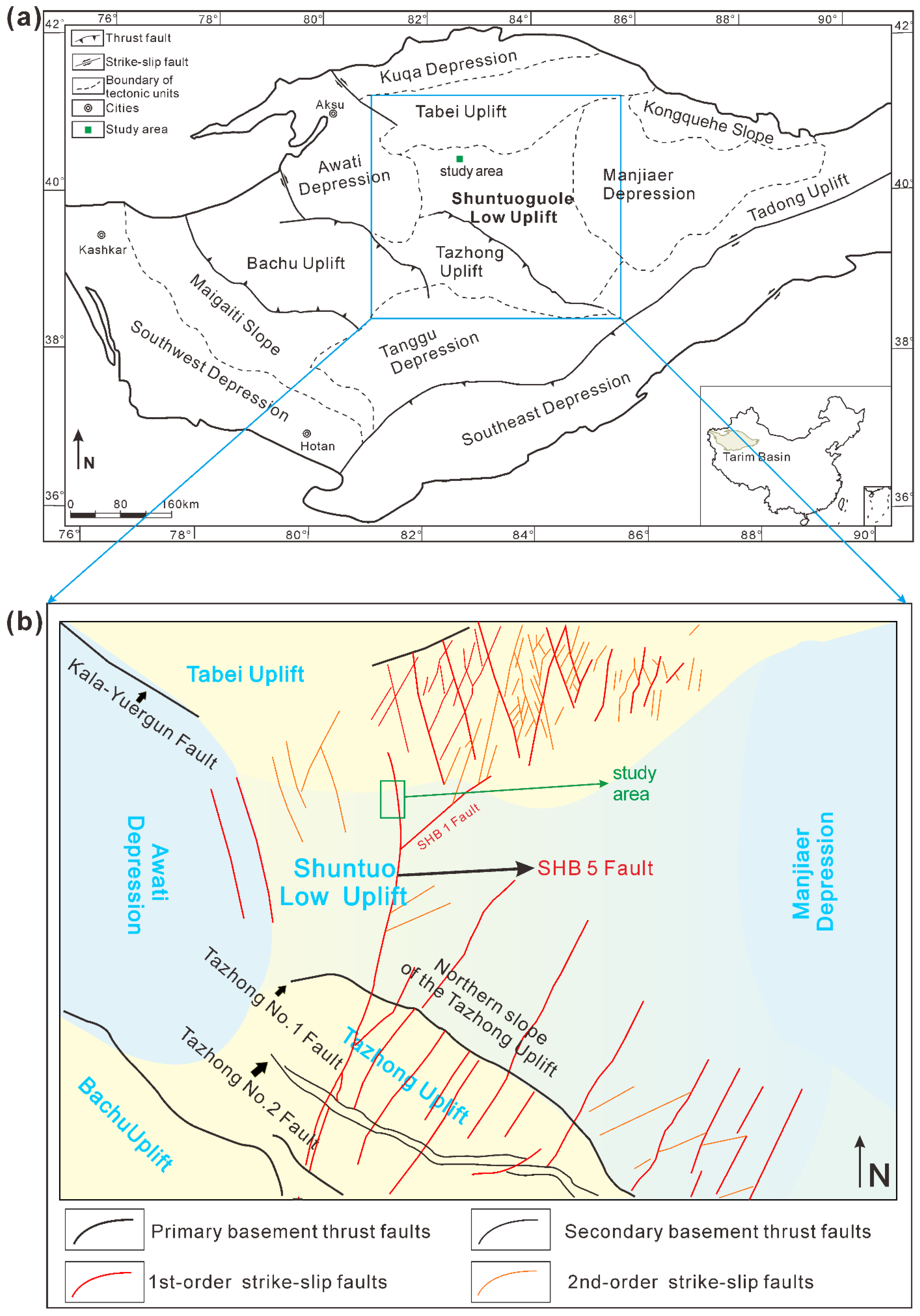
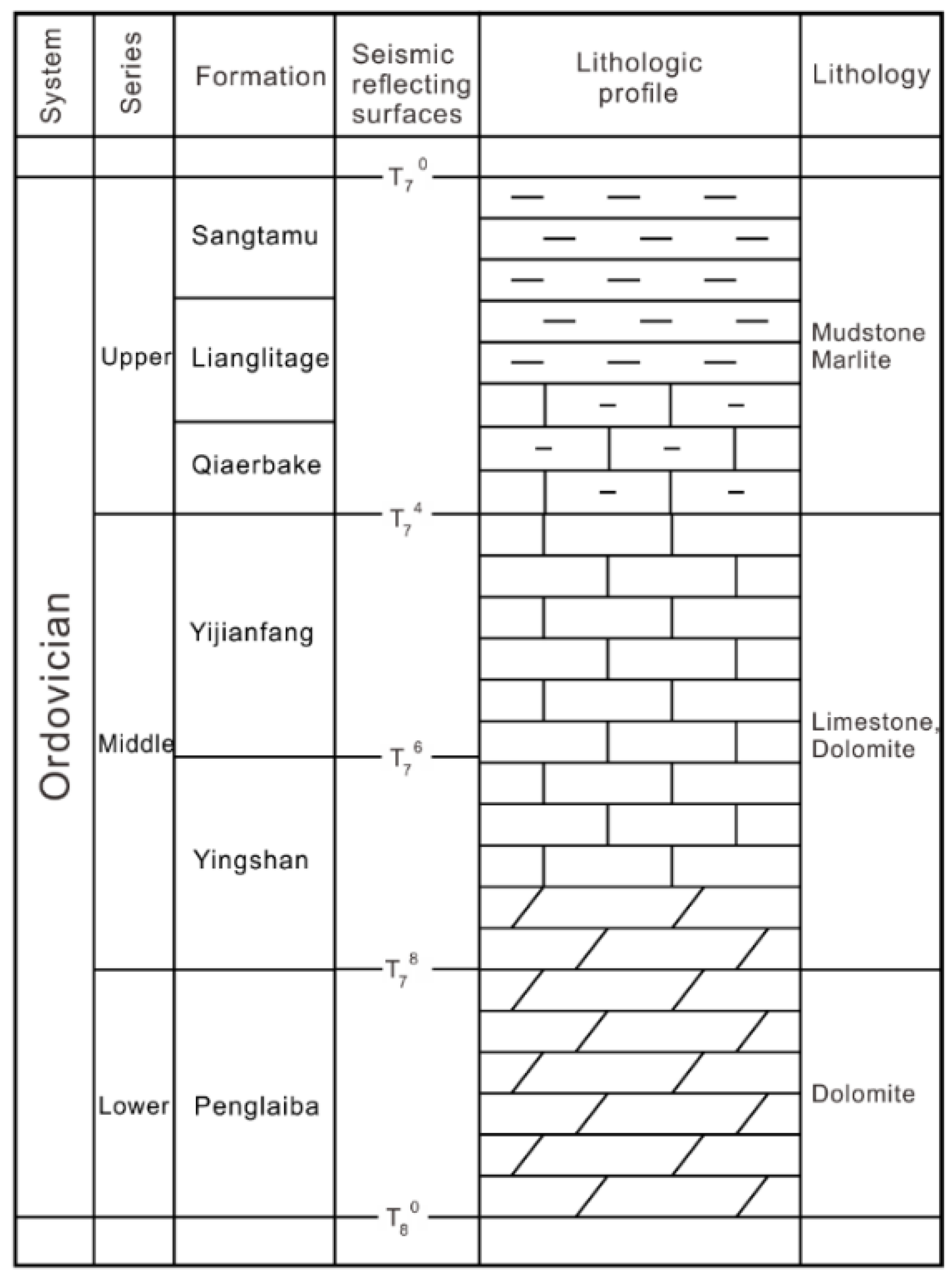
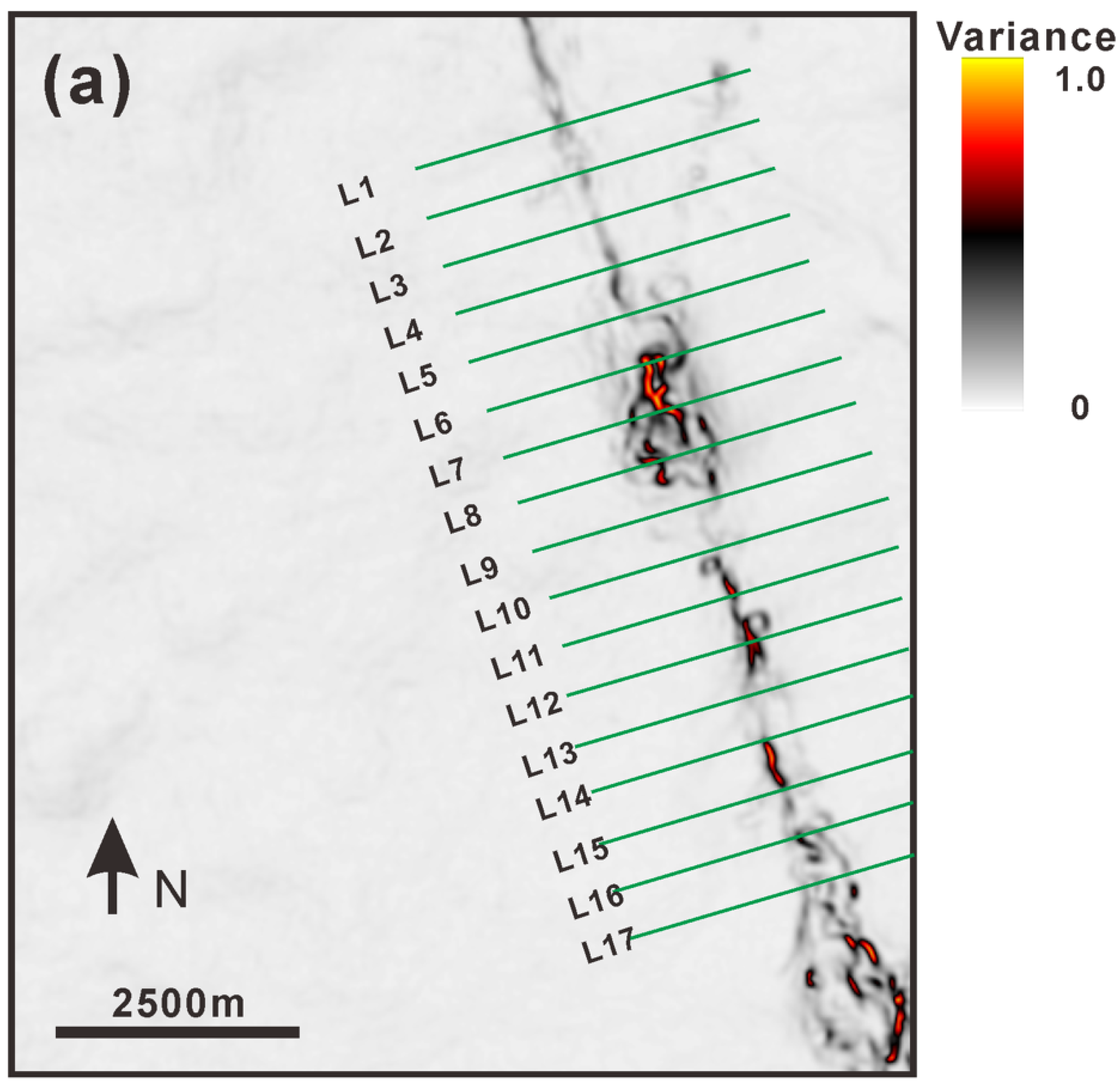
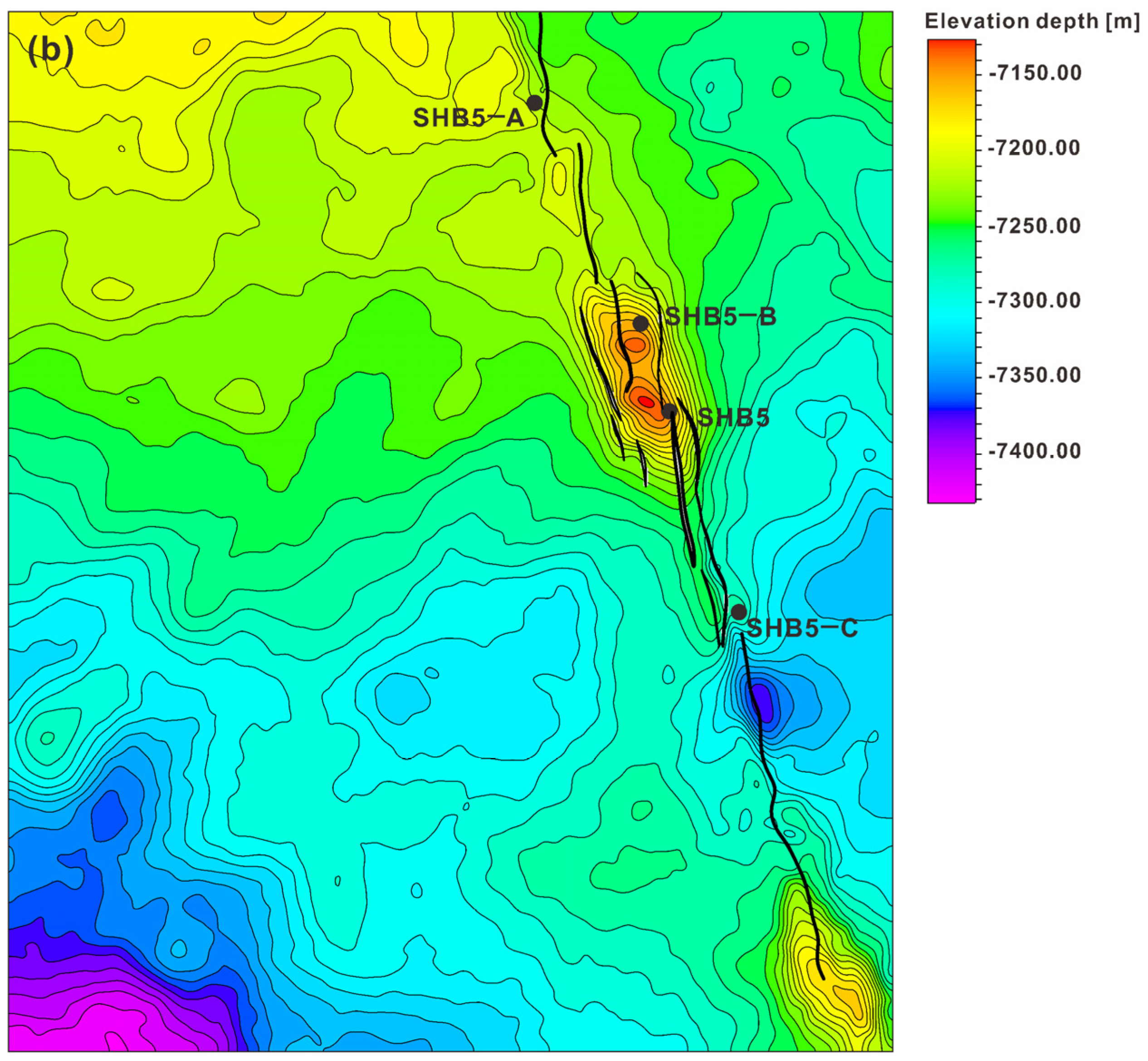
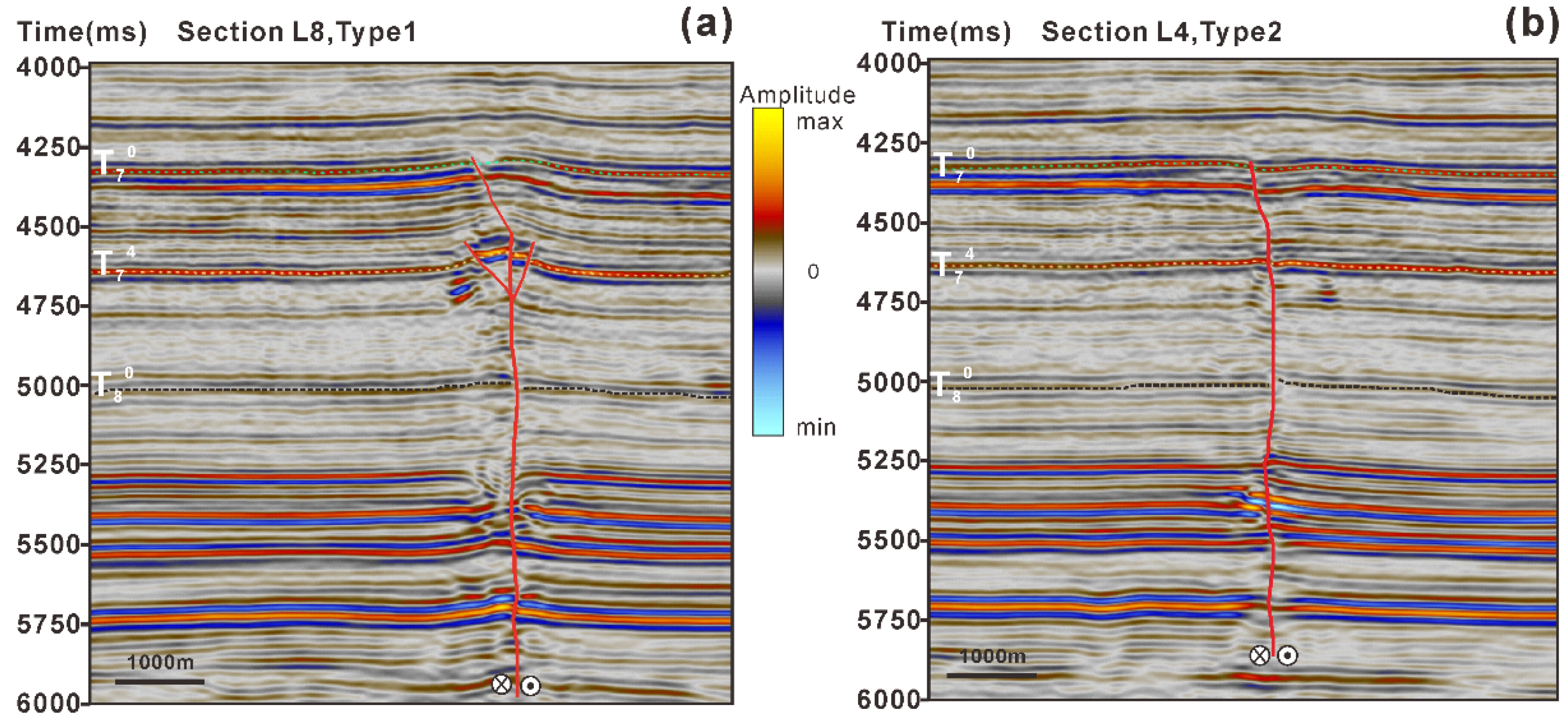
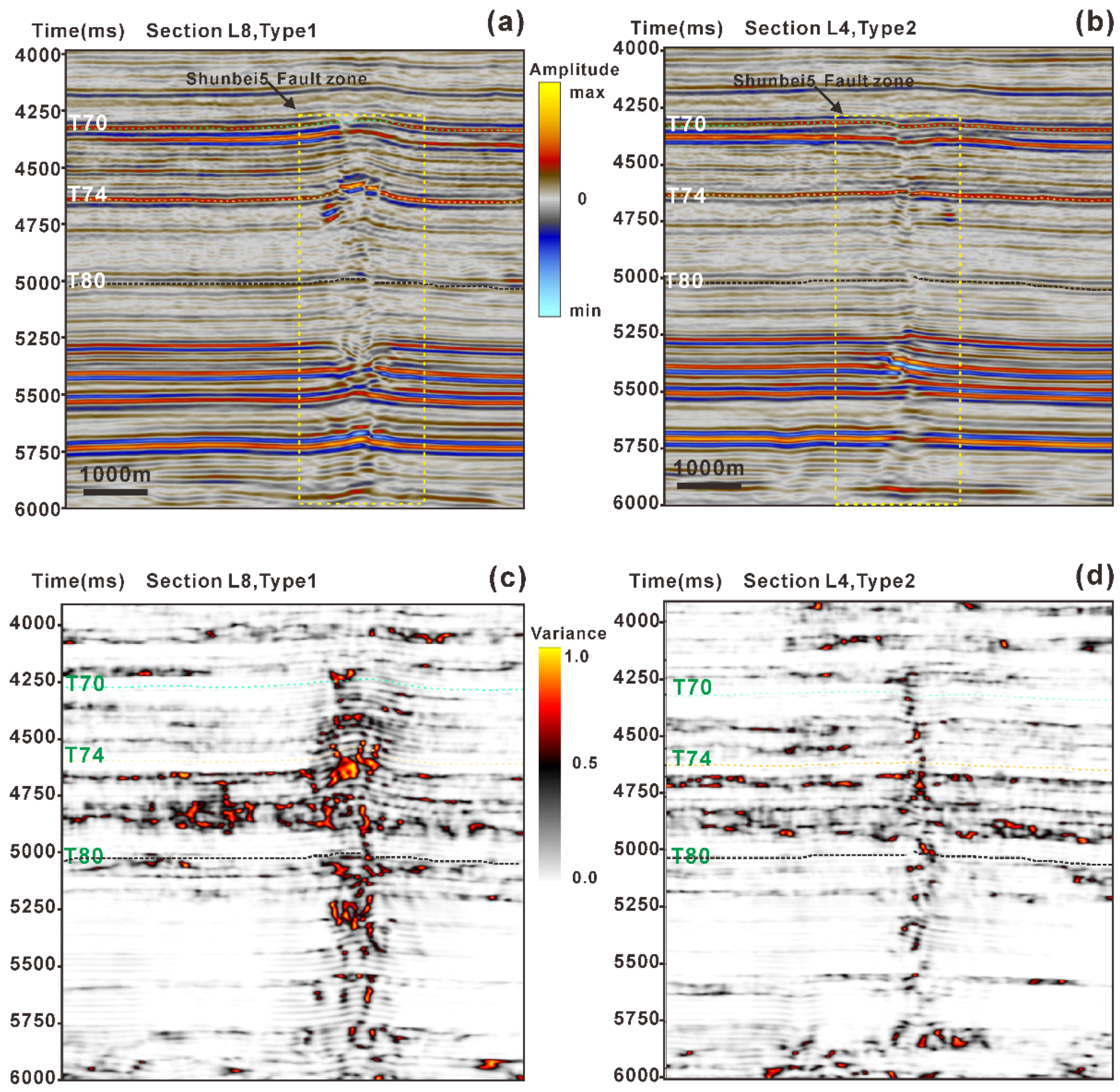
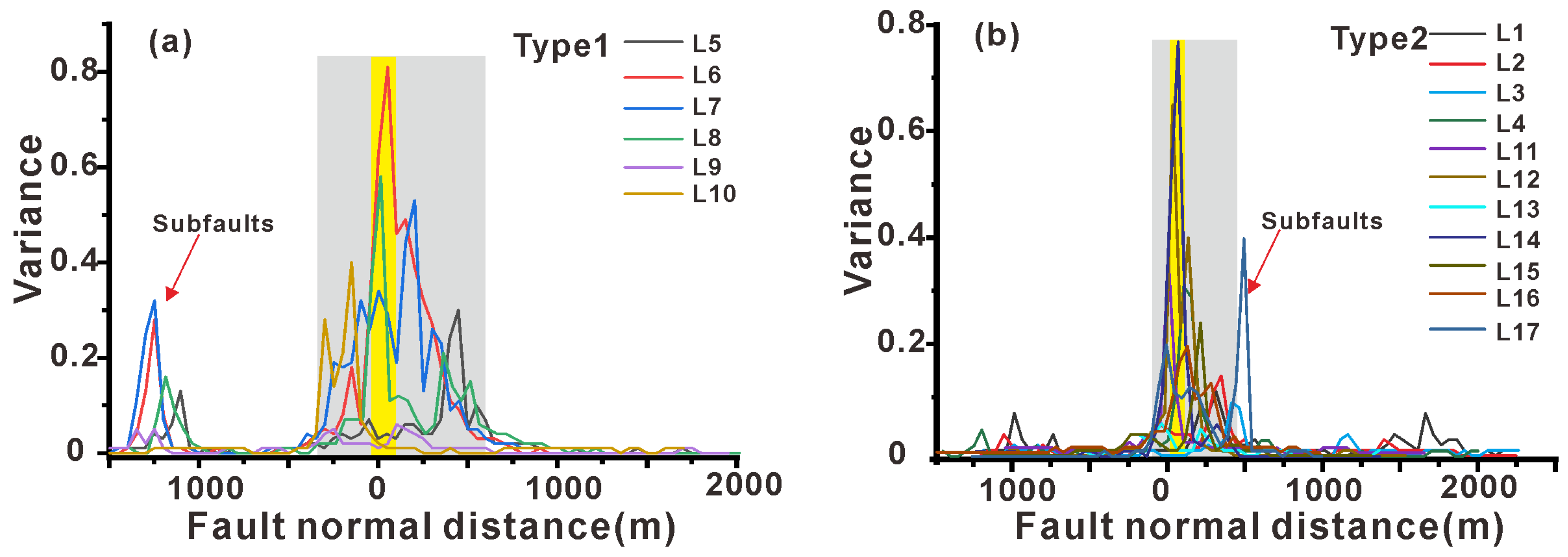
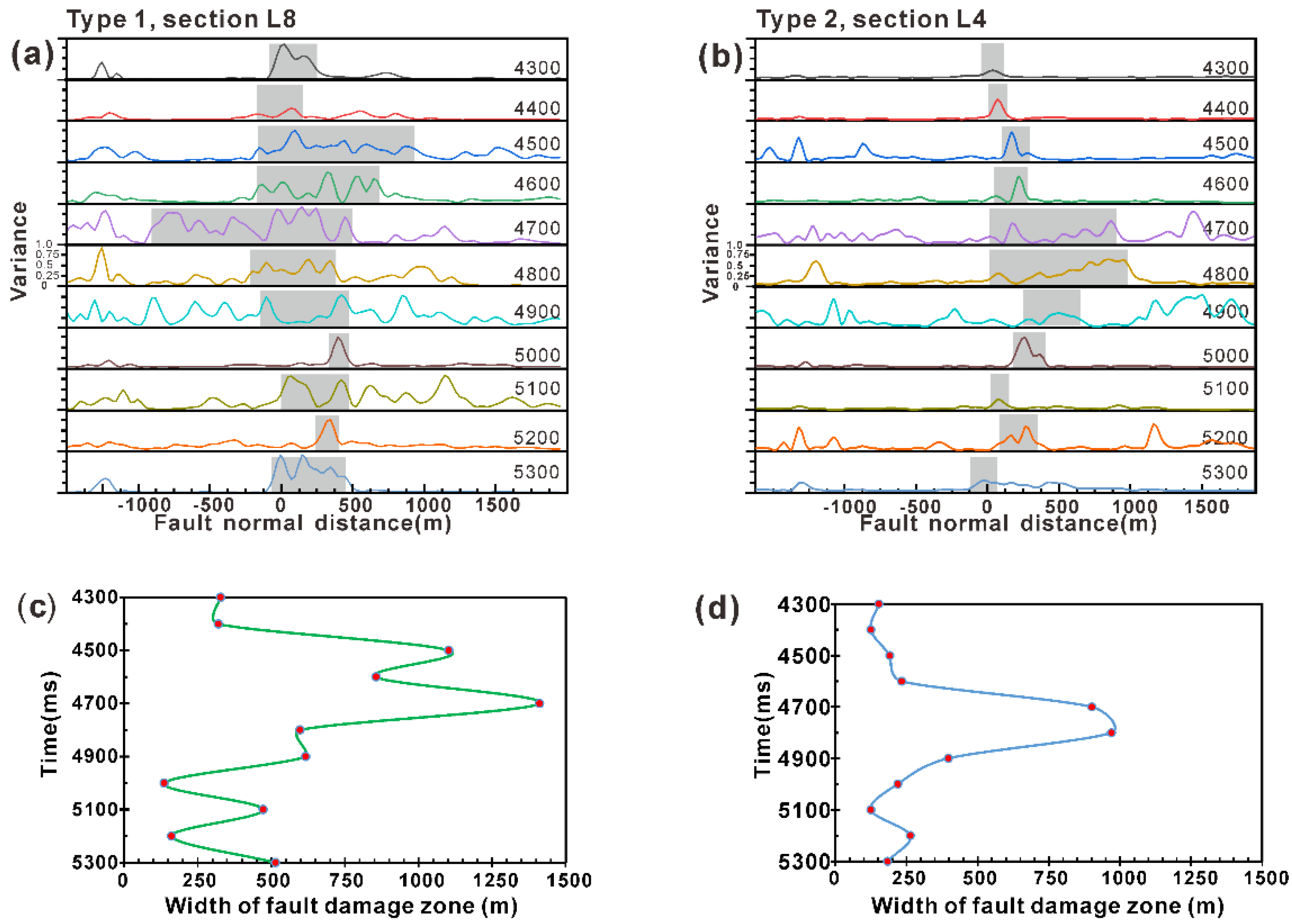

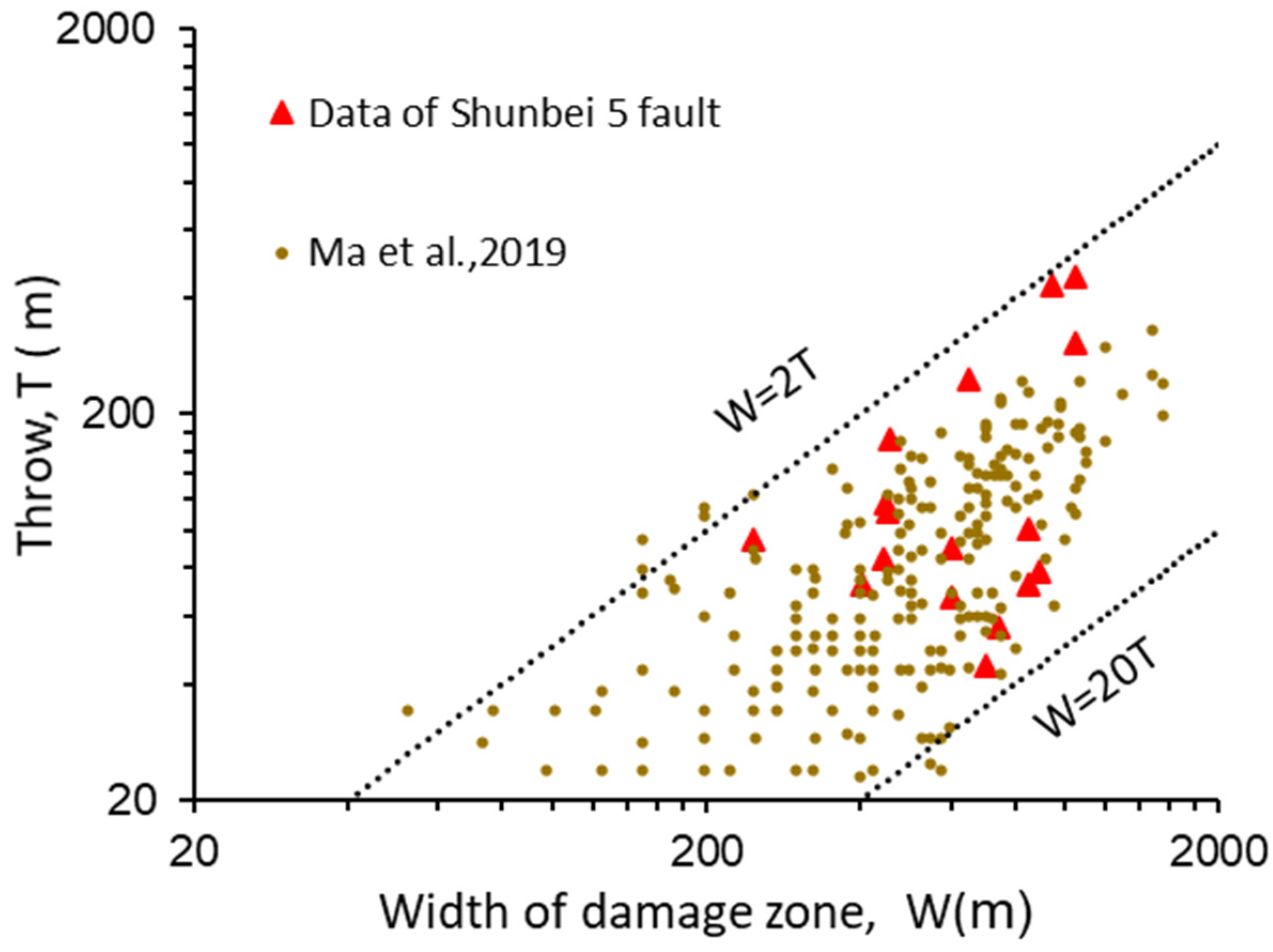
Publisher’s Note: MDPI stays neutral with regard to jurisdictional claims in published maps and institutional affiliations. |
© 2021 by the authors. Licensee MDPI, Basel, Switzerland. This article is an open access article distributed under the terms and conditions of the Creative Commons Attribution (CC BY) license (https://creativecommons.org/licenses/by/4.0/).
Share and Cite
Zhao, Z.; Liu, J.; Ding, W.; Yang, R.; Zhao, G. Analysis of Seismic Damage Zones: A Case Study of the Ordovician Formation in the Shunbei 5 Fault Zone, Tarim Basin, China. J. Mar. Sci. Eng. 2021, 9, 630. https://doi.org/10.3390/jmse9060630
Zhao Z, Liu J, Ding W, Yang R, Zhao G. Analysis of Seismic Damage Zones: A Case Study of the Ordovician Formation in the Shunbei 5 Fault Zone, Tarim Basin, China. Journal of Marine Science and Engineering. 2021; 9(6):630. https://doi.org/10.3390/jmse9060630
Chicago/Turabian StyleZhao, Zhan, Jingtao Liu, Wenlong Ding, Ruiqiang Yang, and Gang Zhao. 2021. "Analysis of Seismic Damage Zones: A Case Study of the Ordovician Formation in the Shunbei 5 Fault Zone, Tarim Basin, China" Journal of Marine Science and Engineering 9, no. 6: 630. https://doi.org/10.3390/jmse9060630
APA StyleZhao, Z., Liu, J., Ding, W., Yang, R., & Zhao, G. (2021). Analysis of Seismic Damage Zones: A Case Study of the Ordovician Formation in the Shunbei 5 Fault Zone, Tarim Basin, China. Journal of Marine Science and Engineering, 9(6), 630. https://doi.org/10.3390/jmse9060630






